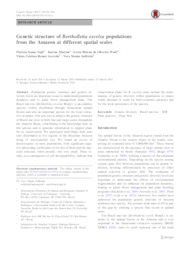Genetic structure of Bertholletia excelsa populations from the Amazon at different spatial scales.
Genetic structure of Bertholletia excelsa populations from the Amazon at different spatial scales.
Author(s): SUJII, P. S.; MARTINS, K.; WADT, L. H. de O.; AZEVEDO, V. C. R.; SOLFERINI, V. N.
Summary: Population genetic structure and genetic diversity levels are important issues to understand population dynamics and to guide forest management plans. The Brazil nut tree (Bertholletia excelsa Bonpl.) is an endemic species, widely distributed through Amazonian upland forests and also an important species for the local extractive economy. Our aim was to analyze the genetic structure of Brazil nut trees at both fine and large scales throughout the Amazon Basin, contributing to the knowledge base on this species and to generate information to support plans for its conservation. We genotyped individuals from nine sites distributed in five regions of the Brazilian Amazon using 11 microsatellite loci. We found an excess of heterozygotes in most populations, with significant negative inbreeding coefficients (f) for five of them and the finescale structure, when present, was very small. These results, as a consequence of self-incompatibility, indicate that conservation plans for B. excelsa must include the maintenance of genetic diversity within populations to ensure viable amounts of seeds for both economic purposes and for the local persistence of the species.
Publication year: 2015
Types of publication: Journal article
Keywords: Bertholletia Excelsa, Brazil nut tree, Brazil nuts, Castanha do pará, Castanha-do-brasil, Dinámica poblacional, Dinâmica populacional, Diversidade genética, Essência florestal, Estrutura genética, Fitomejoramiento, Genetic diversity, Genetic markers, Genetic variation, Madera tropical, Manejo florestal, Marcador genético, Marcador microssatélite, Marcadores genéticos, Melhoramento genético vegetal, Microsatellite repeats, Nuez del Brasil, Plant breeding, Population dynamics, Repeticiones de microsatélite, SSR, Tropical wood, Variación genética, Variação genética, gene flow, plant genetics
Observation
Some of Embrapa's publications are published as ePub files. To read them, use or download one of the following free software options to your computer or mobile device. Android: Google Play Books; IOS: iBooks; Windows and Linux: Calibre.
Access other publications
Access the Agricultural Research Database (BDPA) to consult Embrapa's full library collection and records.
Visit Embrapa Bookstore to purchase books and other publications sold by Embrapa.

